

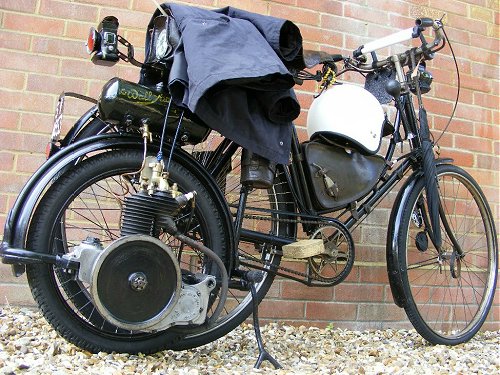
Now, that's a cyclemotor.
This is one of the pair of Wall Auto Wheels that turned up at the West Anglian Group's Great Ouse Cruise. First produced before the outbreak of World War I and remaining in production well into the 1920s, thousands of Auto Wheels were built. BSA and FN both built versions under licence, as did the A O Smith Corporation in the USA. So, although they don'r often appear on runs, and although they're very old, they're not all that rare, with over 100 survivors in captivity.
First published in The MAC in December 2009
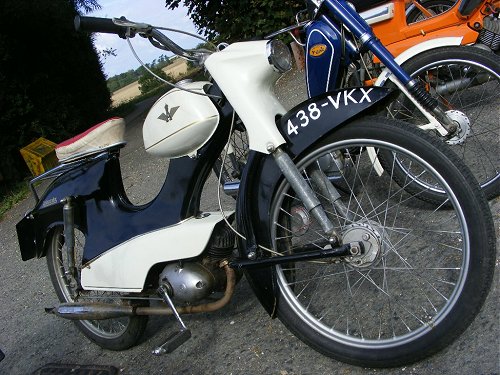
On the other hand, this is nothing like as old as the Wall Auto Wheel, but is much rarer. It is an Ambassador Moped dating from 1961. Although powered by a Villiers 3K engine, the cycle parts didn't originate in the UK. Kaye Don's Ambassador company imported most of the machine from Solifer in Finland. As well as fitting the Villiers engine, the frames were repainted in the UK. In Finland, the equivalent Solifer model was finished in bright red... and that's why this Ambassador has a red top to its seat.
First published in The MAC in December 2009
There was one question that visitors to our stand at the Copdock Motor Cycle Show kept asking us: "Have you seen the Mosquito in the autojumble?"
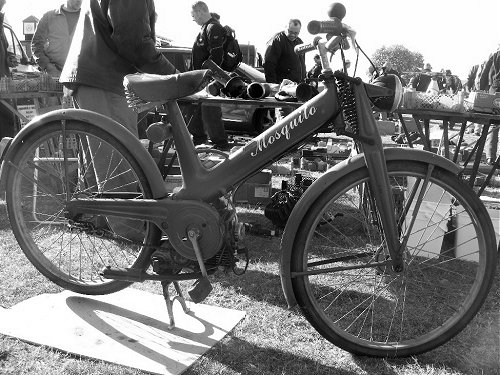
And here it is in glorious black & white. Specialised frames like this were far more common in mainland Europe than in the UK. They would have been sold as a complete machine with the cyclemotor already attached. Here in the UK, the peculiarities of Purchase Tax made buying complete machines like this much more expensive than buying a bicycle and engine separately and putting them together in the comfort of your own shed. This particular machine is probably Italian in origin - well, it is painted bright red. France also had a number of makers of special frames for Mosquito engines. In fact, special frames for Mosquito engines are still being made in France.
First published in The MAC in December 2009
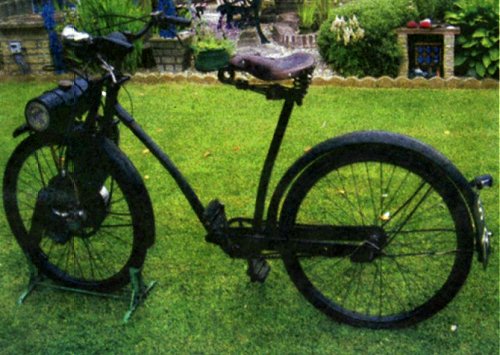
You may have seen that we featured in the "It's Our Club" section of Old Bike Mart in February. Illustrating the article was a picture of this rather intriguing cyclemotor. Many of you will have recognised the engine unit: it's a Cykelaid, made by the Sheppee Motor Company of York at the beginning of the 1920s. The Cykelaid was sold either as a complete machine for £50 or as a motorizing kit for £32. The kit included the engine, front wheel, forks, and mudguard and replaced the front forks of any bicycle or tricycle. The Cykelaid is a rare machine nowadays; we know of just a dozen survivors. However, the engine unit is not the only interesting thing about this machine - there's also the bicycle it's fitted to. That's an unusual machine too and is maybe even rarer than the Cykelaid itself. It's an AGB Super-Elastic Einheitsrad, made in Germany (AGB stands for Amandus Glaser, Berlin) around 1931. The cycle frame is a single tube that curves around beneath the pedal spindle. The chain stay 'blades' bolt to lugs on this main tube. This unusual construction allows the bike to flex over bumps in the road. It also means that there can be no top tube - the frame design was the same for both men and women. This, of course, is where the name comes from: "Super-Elastic" referring to the springy frame and "Einheitsrad" being best translated as "Uni-sex bicycle". Incidentally, it was the staff at Old Bike Mart who chose the illustrations, so we have them to thank for such an interesting picture. To find out more about Old Bike Mart, visit the website at www.oldbikemart.co.uk or write to OBM, PO Box 99, Morton Way, Horncastle, LN9 6LZ
First published in The MAC in March 2010
Maybe doing a "Spotted" from a newspaper is cheating a bit, so let's do a proper one now...
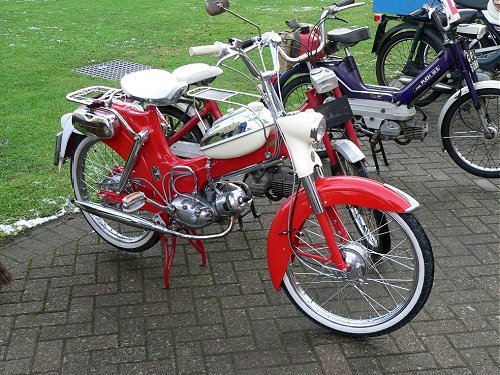
This must have been the shiniest bike on this year's Mince Pie Run. It's a 1968 Puch MS50 and was ridden by Dirk Roest, one of our visitors from the Netherlands. As well as being a very well restored machine, it is also an illustration of a style of bike that's extremely popular with the Dutch. There's a big following for Puch mopeds in the Netherlands and the vast majority of them are the fan-cooled MS/VS types with these high, 'cruiser' handlebars.
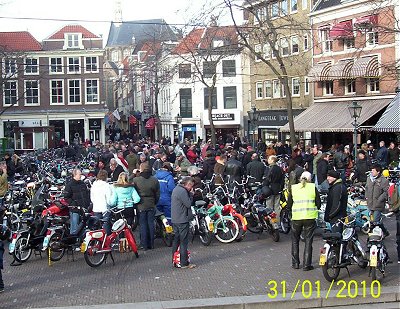
When we say "extremely popular", we're not exaggerating. Jan Gardien and Harry van Sprang, two of our members in the Netherlands, went on the Kâhwe Klâhwe Rit in January. This ride from Scheveningen to Den Haag is just for Puch machines - dozens and dozens of them. Here's one of the pictures that Jan and Harry sent to us.
First published in The MAC in March 2010
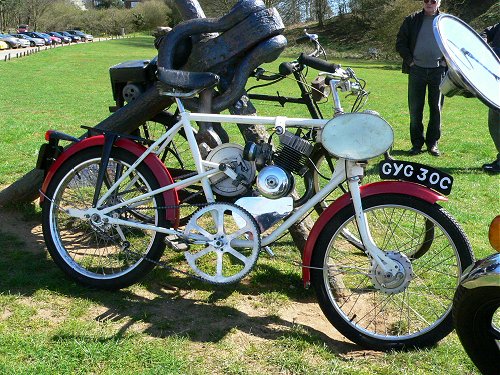
This is Martin Wikner's 'Burdin' cycle pacing machine. This type of bike is also popularly known as a "derny". In the first quarter of the 20th Century, pacing machines or motos de stayer were massive machines. The French Derny company introduced a lightweight version and the name stuck. Martin's machine is powered by a Motobécane engine of 98cc. Apart from its larger capacity, it is very similar to a normal Mobylette engine. These bigger engines were used for Motobécane's vélomoteur class machines like the D52 and D55 (C52 and C55 at Motoconfort). The large chain wheel is a feature of pacing machines - using the pedals helps the rider to adjust the speed to match the demands of the following cyclist. Martin has had to modify his bike slightly to make it road legal - the number plates being the most obvious additions. In some races, several of these bikes are used in a race - one pacing each cyclist - but the best known paced race is probably the Keirin, where one derny is used to pace the entire field. The Keirin is an Olympic event, so you’ll be able to see one in action on the TV soon...
First published in The MAC in June 2010
On 22 May, we put on a club display at the Shuttleworth Collection at Old Warden in Bedfordshire. We had a hugely varied collection of machines as several of our members took the opportunity to show something a bit different from what they'd normally ride on a road run.
In addition to our own bikes, there is a number of cyclemotors, autocycles and mopeds in the Shuttleworth Collection's own museum. These included a Raleigh Wisp, three Corgis, a 1952 New Hudson, a 1958 Cyclemaster in a Phillips cyclemotor frame and this...
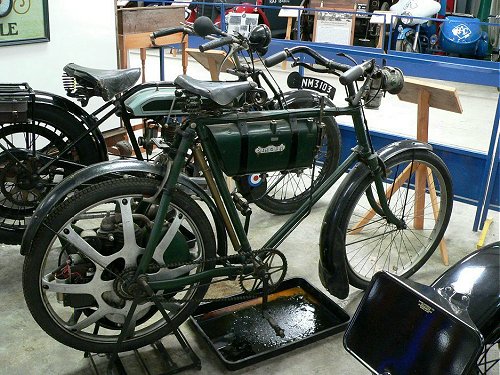
The Singer Motor Wheel looks very much like a forerunner of the Cyclemaster with its engine and fuel tank carried entirely within the rear wheel (the in-frame tank on this one is an auxiliary; the normal tank is in the wheel and also acts as a surface carburetter). It's not really a true cyclemotor because it has to have a special frame. Not only do the forks have to be extra wide to fit around the engine, but they also have special fork ends to fit the Singer’s axle.
The 'power wheel' design made the Singer a versatile machine despite its need for a specially adapted frame. It could also be mounted in the front fork making it particularly suitable for tricycles.
The Singer had some advanced features for its day: the aluminium alloy wheel being the most obvious. It was among the first production machines to use magneto ingnition (although this example has been fitted with a modern coil to boost the ageing magneto). Another 'modern' feature is the twist-grip throttle. The design was patented by Perks and Birch in 1899 and put in production by Singer in 1901. This example has a double-sided wheel but later ones (from 1904) had a single-sided wheel to improve access to the engine (making them even more like a Cyclemaster!)
First published in The MAC in June 2010
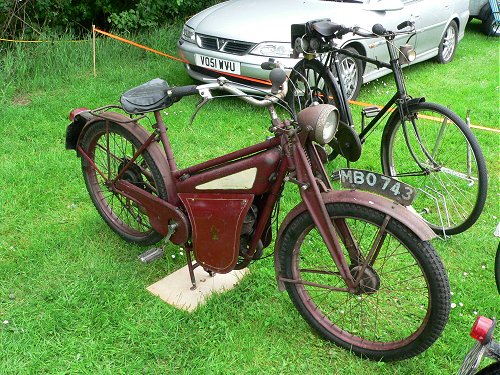
A New Hudson autocycle - the registration number tells us it was first registered in the Spring of 1956, so we know this is a late version of the 'straight-frame' model. The more curvaceous 'Re-styled' was launched in April 1956. This example already has some of the features of the 'Re-styled' model - the headlamp and the rack are the most obvious. It also has the same number plate and rear light as the Re-styled. They won't show up in the photograph, but the transfers on the chainguard are also different from earlier versions.
This short-lived model was announced in November 1955 and is a sort of interim version preceding the introduction of the Re-styled model five months later. Legshields and a windscreen were offered as optional extras on this model; no doubt these were also items that had been developed ready for the launch of the Re-styled model.
Why did New Hudson bother to produce this updated version when the Re-styled was already being developed? This is conjecture, but maybe development of the Re-styled model was behind schedule and they just wanted something to announce at the 1955 Earls Court Show to maintain public interest.
First published in The MAC in September 2010
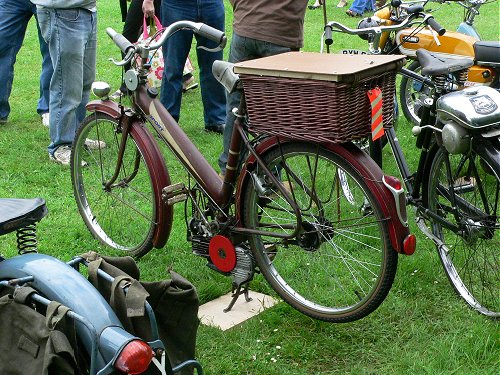
We'll stay with the Horham rally for our second machine. We featured a similar machine as a Spotted Extra last December. That one was on sale in the bike jumble at last year's Copdock Show. Not only was it later bought by a club member, but it was also seen in action at our Mince Pie Run in January.
If you haven't guessed yet, we're talking about Mosquito cyclemotors - and, in particular, Mosquito cyclemotors in purpose-built frames.
Last year's example was the 'official' version: a BMG (Bici-Mosquito-Garelli).
Our featured machine is one of the many independently-produced frames for the Mosquito: a Presto Sport.
This is a rigid machine, unlike the BMG, which had full suspension. It does have resiliently-mounted handlebars, however. The Mosquito-specific features are the front engine mounting and the remote engagement lever. With only minor changes these frames were produced to suit a number of different auxiliary engines. The luggage rack is part of the frame - not a bolted on afterthought. Fluted pedal cranks and inverted brake levers make it an elegant machine.
It's French, which means that the Mosquito is quite likely not a Garelli one. The French company of Chapuis Frères made them under licence. Coincidentally, Pete Stratford had an almost identical machine for sale at the VMCC Founder's Day Rally in July.
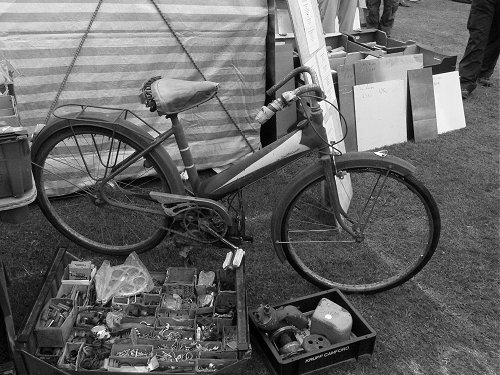
Presto/Mosquito on Pete Stratford's stand at Founder's Day
First published in The MAC in September 2010